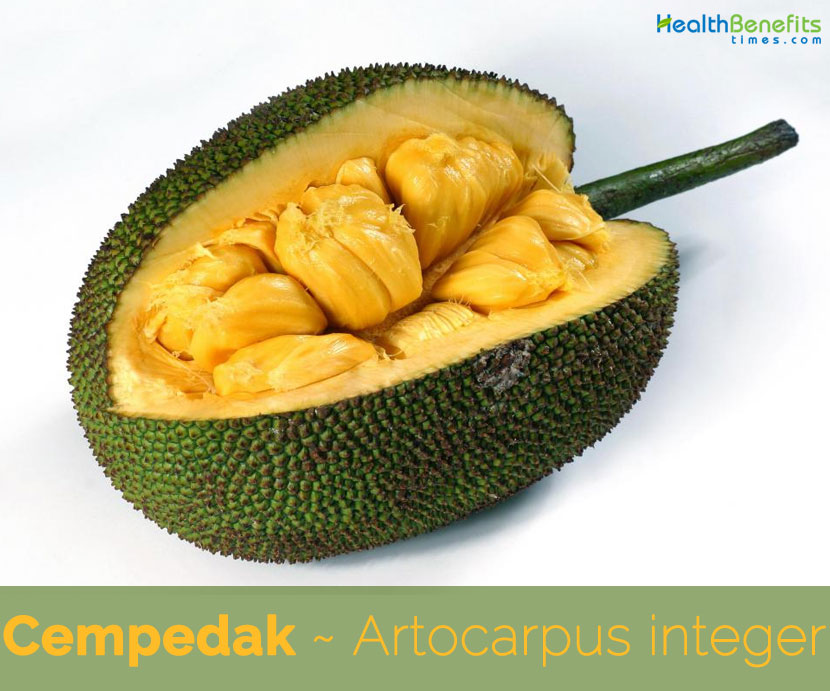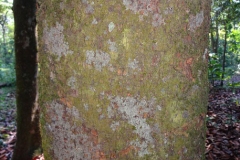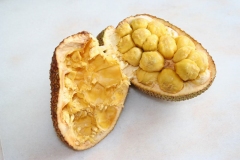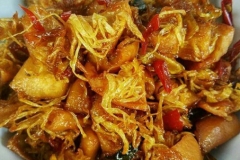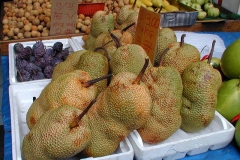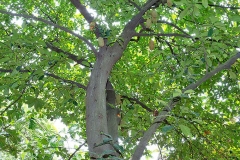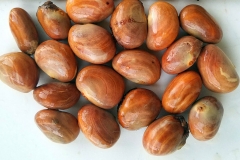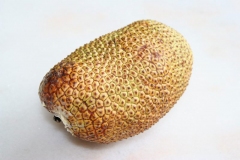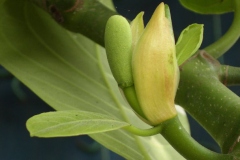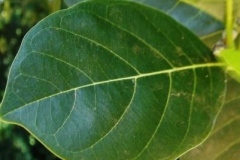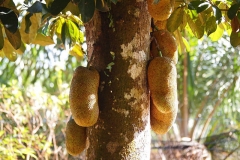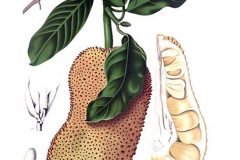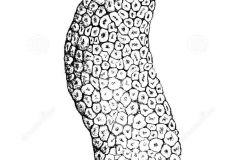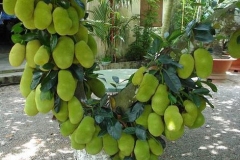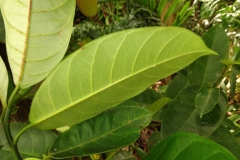Champedan, Chempedak, Small Jackfruit, Bangkong, Banturung manuk, Baroh, Beluno, Bukoh, Campedek, Champada, Chubadak, Kakan, Mangkahai, Nakan, Nangka berit, Nangka tjomedak, Pulutan, Sempedak, Sonekadot, Temedak, Tibadak and Tibudak are some of the popular common names of the plant. The genus name Artocarpus is derived from the Greek words artos, meaning bread and karpos, meaning fruit, referring to the bread-fruit tree. The specific epithet integer is from Latin, meaning undivided, entire, intact or whole.
Plant description
Cempedak fruit is an evergreen, medium–sized, mid-canopy, branched, monoecious tree that grows about 10–30 m tall. The plant is found growing in secondary forests and locally abundant in primary lowland rainforest, often on wet hillsides. The plant thrives on humus-enriched, loamy, acidic and well-drained soils, but prefers a fairly high water table. However, it does best in deep alluvial soils of open texture. It can also survive periodic water-logging. Stem has white sap; brown stiff, reflexed hairs 3 mm long cover the twigs, stipules and leaves.
Trunk
Cempedak plant is smaller than the jackfruit plant with an optimal diameter of 15 to 20 cm. Because classified into the family Moraceae, cempedak plant consists of thick sap. The plant has a smooth, grayish-brown surface with bumps on the trunk and main limbs where leafy twigs are produced, which bears the fruits. It is also very suitable to be used as raw materials for making household utensils because it is classified strong and resistant termites.
Leaves
Its evergreen and alternate leaves are obovate to elliptical in shape, 5-25 cm long and 2.5-12 cm wide. The base is cuneate to rounded, with entire margin, and acuminate apex, glossy green above and pale green and pubescent below. The lateral veins are in 6–10 pairs and curve forward. The medium green leaves held on 1-3 cm long petioles are usually covered with hairs on the midrib and main veins. New shoots, leaf and flower stalk are covered with thin but wiry brown hairs.
Flower
Flower is monoecious, bearing both male and female flowers on the same tree. The flowers are borne on solitary stalked inflorescence that can be at the leaf axil, on the tree trunk or on the branches.
The male flowering head is cylindrical in shape, 3-5.5 cm long and 1 cm wide, and is yellowish-white in color. Most male heads are formed on shoots in the periphery of the canopy that may facilitate pollination by wind. The female flowering head is similar but with distinct filamentous styles on it. The small and greenish female flower heads are found only on cauliflorous shoots. Flowers are cream or off-white and located axillary. Insects visit the scented male inflorescence but not the female ones as they lack nectar. Flowering normally takes place from February to April and then again in August to October.
Fruit
After the pollination occurs, the female flowers will grow into cempedak fruit which is generally round elongated shape. The average size of cempedak fruit is 20-40 cm long and 10-20 cm in diameter and weighing 1-6 kg. Thorns on the skin of cempedak fruit are not as sharp and as rough as jackfruit. Cempedak fruit is yellowish green when young and becomes brownish-yellow when it is old (ripe).
The outer layer of the fruit is green, thick, leathery and patterned with hexagons that are either flat or raised protuberances like the Jackfruit’s skin. The fruit’s taste is comparable to the related Jackfruit (Artocarpus heterophyllus) with a hint of durian. Compared with Jack fruit, Cempedak is sweeter, aromatic, less fibrous and less acidic. Like the Jack fruit, it is a syncarp, composed of fleshy arils or segments, 3-4.5 cm across, colored pale yellow, yellow, orange or green. Each aril surrounds a seed that is edible by boiling or roasting.
Seed
Cempedak seeds are smaller than jack fruit seeds with shape slightly round, just like the flesh. Just like jack fruit, cempedak seeds can also be consumed after boiling. Seeds are flattened spheres or elongated, about 2-3 cm long. Unlike Jack fruit seeds, they have a thin and edible seed coat.
Health Benefits of Cempedak
Listed below are some of the well-known health benefits of Cempedak fruit
1. Heart health
Antioxidants, dietary fiber and vitamin C present in cempedak help in maintaining heart health. High potassium content helps in lowering blood pressure. It decreases cholesterol levels and reduces hypertension that makes the cardiac system healthier.
2. Healthy eyes
Cempedak fruit consists of good amount of Vitamin A which helps to increase health in our eyes. There are many fruits and vegetables that contain Vitamin A but Cempedak fruit becomes one of the sweetest and delicious fruits to be consumed as a supplier of Vitamin A in the body.
3. Maintain digestion
Cempedak fruit is also able to help and keep the digestive in our body running smoothly. Vitamin C content in this fruit is able to avoid us from constipation or difficult to defecate.
4. Prevent the risk of stroke
Stroke disease becomes a disease that mostly suffered by people who continue to use. But not a few of them are still young age of these disease even children. Cempedak fruit also provides benefits in this regard by preventing the risk of stroke.
5. Lower cholesterol in the blood
Cempedak fruit also has benefits for our body in terms of lowering cholesterol levels. Vitamin C content can repel bad cholesterol to prevent blood flow and help good cholesterol to flow smoothly. Bad cholesterol can cause many serious illnesses like heart disease.
6. Relieve tumor
There are many health experts who say that Cempedak fruit is able to help treat tumor diseases. But until now there has been no definite thing about it. Seeing from its content such as bioflavonoid most likely can indeed help relieve tumors.
7. Slimming body
Consuming Cempedak fruit will give a sense of satiety. This makes Cempedak fruit suitable for their food ingredients or you are committed on slimming. The nutritional content is enough to give a sense of satiety as well as forming the body.
8. Malaria treatment
Several compounds like artioindonesianidin and heteriflavon C present in the bark and fruit of cempedak help in prevention and treatment of malaria. It can eliminate the malarial parasites to complete extent.
9. Expel the parasite
In the body, we can roam many parasites that can disturb the work of organs. In addition, these parasites can also cause unexpected diseases, Cempedak fruit has benefits to expel parasites – parasites that are not needed by our bodies.
Traditional uses and benefits of Cempedak fruit
- In traditional folkloric medicine, the Iban in Sarawak apply a paste of the inner bark to heal wounds and prevent infection.
- Juice of the roots has been used for fever in Peninsular Malaysia.
- Ash from burnt leaves, maize and coconut shell has been used to treat ulcers.
- An infusion of the root ash is mixed with Selaginella ash and prescribed as a protective medicine after childbirth.
- Bark is used in poultices for painful feet, hands and for ulcers.
- Leaves are heated and applied to wounds in Philippines.
- Pith has been reported to cause abortion and the wood is sedative.
- Unripe fruit is astringent and ripe fruit laxative.
- Jackfruit intake prevents Obesity and Heart Diseases.
- It regulates the cholesterol level and reduces high cholesterol or bad cholesterol in the body.
- It contains good amount of potassium and treats high blood pressure and maintains the Blood Pressure level in the Body.
- It prevents digestive disorders and treats indigestion and constipation.
- It boosts the immune system and aids in the production of Red Blood cells.
- It helps in reducing the high blood sugar level in diabetic person.
- It strengthens the bones and prevents osteoporosis.
- It combats skin diseases. It hydrates dry skin.
- It slows the aging process.
- It combats against cold, cough, flu, piles, weak eyesight and asthma.
Ayurvedic Health benefits of Cempedak fruit
- Infertility: Take roasted seeds of Jackfruit twice a day.
- Ulcers: Add Coconut oil to the burnt leaves of Jackfruit. Apply it thrice a day on the infected skin.
- Fever: Prepare a decoction of Jackfruit root. Take it twice a day.
- Ulcers: Burn the leaves of Jackfruit, Corn and Coconut Shell together. Mix Coconut oil to make paste. Apply over the affected area.
Culinary Uses
- Sweet, fragrant and flavorsome, fleshy perianth of the fruit is eaten fresh or preserved in syrup.
- In Malaysia, 1–2 perianth balls are coated with flour and deep fried to make into fritters for consumption as dessert or snacks.
- Ripe and unripe flesh is salted in Malaysia and used as a pickle called jerami.
- Perianths are also candied or made into chips by sun-drying.
- Young fruits are cooked in coconut milk and eaten as a curried vegetable or in soup or made into pickles.
- Seeds are rich in starch, eaten roasted or after boiling in salty water for 30 min and peeling off the seed coat.
- Seeds have a pleasant, nutty flavor.
- Starchy flour may be obtained from the seeds.
- Young, tender leaves are also cooked as vegetables in Sarawak.
- Unripe fruit is used as a cooked vegetable or is added to soups.
- Ripe seeds roasted or boiled can be eaten as a delicacy.
- Immature fruits can be cooked and eaten as a vegetable or made into pickles.
- Edible seeds can be fried, boiled or grilled and eaten with a pinch of salt.
- Fritters are made by dipping arils in batter and frying in oil.
- Young fruits are cooked in coconut milk and eaten as a curried vegetable or in soup. The seeds are eaten roasted or boiled.
Recipe
Cempedak Butter Cake
Ingredients:
- 200-350 grams of butter
- Sugar as required
- 250 grams of self-raising flour
- 4 eggs
- 200 grams of cempedak flesh.
Directions
- Cut the flesh to tiny pieces without making it mushy.
- Mix the sugar and butter until it becomes fluffy.
- Add eggs and flour alternately.
- Mix in the flesh gently and bake all together.
- Try to avoid mixing up of the flesh and the cake batter together.
- Bake it at 180 deg. Celsius for around 45 minutes.
Cempedak Deep-Fried Fritters
Ingredients
- 1 kg of Cempedak Fruit
- Oil as required
- 70 g Rice Flour
- 10 g Corn Flour
- Sugar if needed
- Salt as required
- 1 full Cup of Water
Direction
- Peel the fruit and take the flesh alone in a bowl.
- Combine Rice Flour, Corn Flour, Sugar, Salt and Water for batter and mix well.
- Pour enough oil into a pan on medium to high heat.
- Cover the Cempedak flesh with batter and fry until it turns golden brown in color.
- Remove the Cempedak fritters and serve warm.
Goreng Cempedak
Ingredients
- 1 Cempedak
- 3 tbsp. Self Raising Flour
- 2 tbsp. Corn flour
- 1 tbsp. Rice Flour
- 1 tbsp. Wheat Flour
- Salt as required
- 1 cup of Water
Direction
- Combine all the flour and salt in a bowl.
- Also add water to it and combine into a batter.
- Cover cempedak in batter and deep fry in hot oil until crispy and golden brown.
- Remove and serve.
Other Facts
- In Kerala and Bengal in India, the leaves are used as fodder.
- Ripe fruit is fed to cattle and the fruit, leaves and bark are used to feed elephants.
- Bark can be used to make rope and the resinous latex for the preparation of bird- lime and vanishing material.
- Bark is also rich in tannin.
- Dark yellow to brown wood is strong and durable and is used for building construction, furniture, boats cabinet-work, brush-handles.
- Wood is used for musical instruments, furniture, cabinet-work and tool-handles in Philippines.
- The wood also makes a good fuel-wood.
- Buddhist used the timber for construction of sacred buildings on account of its yellow color in Indo China.
- With alum, the extract of heartwood provides a yellow dye that is moderately fast on silk.
- Yellow dye is used in coloring the saffron-colored robes of Buddhist monks in Indo-China.
- Tree has been planted in conjunction with cash crops such as Carica papaya, in reforestation systems.
- Tree has been used as shade tree for coffee but was found to be not ideal.
- Bark yields a fiber that is used in making ropes.
- Resin can also be obtained from the tree and it is used as a varnishing material.
- Each fruit can weigh from 600 – 3,500 g.
- All parts of the tree contain milky latex when cut.
- Trees begin to bear fruit at 3-6 years for trees planted by seed and at 2-4 years for clonal trees.
- Total edible portion (perianths + seeds) is 25-50% of fresh fruit weight.
- Tree is well suited for reforestation projects in association with other species.
- Latex obtained from the plant can be used for making lime.
Precautions
- Avoid use during pregnancy as it may cause abortion.
- It may cause allergic reaction in people suffering from birch pollen allergies.
- It may increase blood coagulation.
- Cempedak fruit contain much ascorbic Acid is recommended not to consumed in excess amounts as it can make gas in the stomach.
References:
https://www.itis.gov/servlet/SingleRpt/SingleRpt?search_topic=TSN&search_value=565608#null
https://davesgarden.com/guides/pf/go/176958/
https://pfaf.org/user/Plant.aspx?LatinName=Artocarpus+integer
https://plants.usda.gov/core/profile?symbol=ARIN17
https://www.wikidata.org/wiki/Q1053368
http://www.theplantlist.org/tpl1.1/record/kew-2653995
https://en.wikipedia.org/wiki/Artocarpus_integer
https://uses.plantnet-project.org/en/Artocarpus_integer_(PROSEA)
http://ecocrop.fao.org/ecocrop/srv/en/cropView?id=3435
http://www.asianplant.net/Moraceae/Artocarpus_integer.htm
http://tropical.theferns.info/viewtropical.php?id=Artocarpus+integer
https://gd.eppo.int/taxon/ABFIN
https://infocultures.blogspot.com/2017/05/cempedak-benefits-and-information.html
https://www.cabi.org/isc/datasheet/1834
Comments
| Cempedak fruit Quick Facts | |
|---|---|
| Name: | Cempedak fruit |
| Scientific Name: | Artocarpus integer |
| Origin | Thailand, Peninsular Malaysia, Sumatra, Java, Borneo (throughout the island), Sulawesi, Maluku, New Guinea |
| Colors | Yellowish green when young and becomes brownish-yellow when ripe |
| Shapes | Round elongated shape, 20-40 cm long and 10-20 cm in diameter and weighing 1-6 kg |
| Flesh colors | Golden-yellow |
| Taste | Acrid, sweet, astringent |
| Health benefits | Heart health, Healthy eyes, Maintain digestion, Prevent the risk of stroke, Lower cholesterol in the blood, Relieve tumor, Slimming body, Malaria treatment, Expel the parasite |
| Name | Cempedak fruit |
|---|---|
| Scientific Name | Artocarpus integer |
| Native | Thailand, Peninsular Malaysia, Sumatra, Java, Borneo (throughout the island), Sulawesi, Maluku, New Guinea |
| Common Names | Champedan, Chempedak, Small Jackfruit, Bangkong, Banturung manuk, Baroh, Beluno, Bukoh, Campedek, Champada, Chubadak, Kakan, Mangkahai, Nakan, Nangka berit, Nangka tjomedak, Pulutan, Sempedak, Sonekadot, Temedak, Tibadak, Tibudak |
| Name in Other Languages | Borneo: Banturung Manuk, Bukoh, Chempedak, Mengkahai, Nakan, Pulutan, Temedak, Temedak Man Burmese : Sonekadat Chinese: Mu bo luo, Xiǎo bōluómì (小波羅蜜) English: Chempedak, Small jackfruit, jack tree, champedak, tjampedak Fijian : Uto Ni Idia Hindi: Kathal, Kathar, katol, lemasa Indonesia : Campedak, Cempedak, Comedak, Tundak, Tuadak, Tawerak, Anaane, Tuada, Cempeudak, Cimpedak, Sibodak, Bikawau, Cubadak, Temedak, Kakan, Akam-Akam, Tamberak, Campedak, Baroh, chempedak Japanese: Koparamitsu Malay: Baroh, Baduk, Campedak, Cempedak, Nangka, Nangka liar, pokok cempedak Malaysia : Chempedak, Campedak, Baroh, Bankong, Bongkong; Takah, Deko, Menelang Malayalam: Chakka Sanskrit: Atibrhatphala, Kantakiphala, Panasa Sinhalese: Pani varaka, kos gasa (කොස් ගස), bat gasa (බත් ගස), heraḷi gasa (හෙරළි ගස) Sri Lanka : Pani Varaka Swedish: Champedak Tamil: Chakka, Pilual Telegu: Panasapandu Thailand : Champada, Cảpāda (จำปาดะ) Vietnamese : Mít Tố Nữ |
| Plant Growth Habit | Evergreen, medium–sized, mid-canopy, branched, monoecious tree |
| Growing Climates | Secondary forests and locally abundant in primary lowland rainforest, often on wet hillsides |
| Soil | Thrives on Humus-enriched, loamy, acidic and well-drained soils, but prefers a fairly high water table. However, it does best in deep alluvial soils of open texture. It can survive periodic water-logging |
| Plant Size | 10–30 m tall |
| Trunk | Bumpy with a grey-brown to dark brown bark |
| Bark | Greyish brown with bumps on the trunk and main limbs where leafy twigs are produced, which bears the fruits |
| Twigs | 2.5–4.0 mm thick, terete with annulate stipular scars |
| Stipules | Ovate triangular- oblong, dark green and up to 9 cm long |
| Leaf | Alternate and borne on 1–3 cm long petiole. The lamina is obovate to elliptic, 5–25 × 2.5–12 cm in size, and the base is cuneate to rounded, with entire margin, and acuminate apex, glossy green above and pale green and pubescent below. The lateral veins are in 6–10 pairs and curve forward |
| Inflorescence | Solitary, unisexual, cauliflorous or ramiflorous and borne on the axillary position of short leafy shoots |
| Flowering season | February to April and then again in August to October |
| Flower | Male heads are cylindrical, 3–5.5 × 1 cm, with small, 1 mm diameter, yellowish flowers with 1 straight stamen and 2 oblong, concave, whitish-yellow perianth segments. The female heads have small, tubular flowers, with perianths cohering at base and simple filiform styles with a 1.5 mm long exerted stigma |
| Fruit Shape & Size | Cylindrical to oblong cylindrical, densely beset with short pyramidal, faintly prominent tubercles, 20–35 cm × 10–15 cm in size and borne on 7–12 cm long peduncle |
| Fruit Color | Green when young turning to yellowish, brownish, or orange-yellow |
| Flesh Color | Golden-yellow |
| Seed | Flattened spheres or elongated, about 2-3 cm long |
| Propagation | By seeds |
| Taste | Acrid, sweet, astringent |
| Plant Parts Used | Seeds, fruit, leaves, latex |
| Health Benefits |
|


